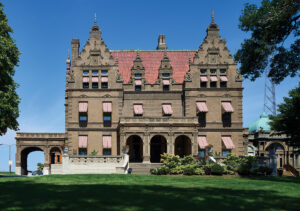Country Railways, by Paul Atterbury, Trafalgar Square, North Pomfret, Vermont 05053, $17.95, hardback.
As Paul Atterbury points out in the introduction to Country Railways, William Wordsworth positively loathed railroads; not because of inefficiency or overcrowding or high-priced tickets, but because of the marks they left on the landscape. Indeed, during the Victorian Age, railroads penetrated into nearly every corner of the British Isles, and armies of navvies laboured to carve passages through hills and forests, and over rivers and ravines.
But with the passing of rail travel’s heyday, fewer people are inclined to echo Wordsworth’s disparaging opinion of the railways’ effect on the landscape. Today, the rails, stations, and other associated reminders of the age of rail travel are themselves a picturesque part of a romantic past that many people look back on with sentimental nostalgia, a past they think worthy of preservation in its own right.
Atterbury contributes to this trend with the 36th volume of Weidenfeld & Nicolson’s ‘Country’ series. Aided by Ian Burgum’s beautiful photographs, Atterbury tells the stories of some of Britain’s most scenic rail lines.
Sites include the soaring viaducts at Calstock, on the Plymouth to Gunnislake line; Chappel on the short Colchester to Sudbury line, and Batty Moss on the Settle to Carlisle railway. The now obsolete signal boxes are endangered by the advent of more recent rail technologies. While they are becoming increasingly rare, picturesque examples still stand along the Ipswich to Lowestoft line, and along the rails between Norwich and Sheringham.
Perhaps the most evocative reminders of the golden age of rail travel are the country station houses, which range in style from the quaint to the grand, and typically embody a thoroughly Victorian atmosphere. Atterbury and Burgum introduce readers to several, including the charming half-timbered stations of the Bedford to Bletchley line, with their ginger-bread-house façades, to the Italianate elegance of Ulverston Station on the Cumbrian coast.
And as this book makes obvious, with images such as that of the Scottish Highlands near Mallaig, British railways did not just mar the landscape, as Wordsworth complained; they also opened up, for millions of travellers, spectacular views of Britain’s most breathtaking vistas. Despite the intrusion, many of these views remain as lovely today as they did in the Victorian Age. They’re worth the look.
Bruce Heydt




